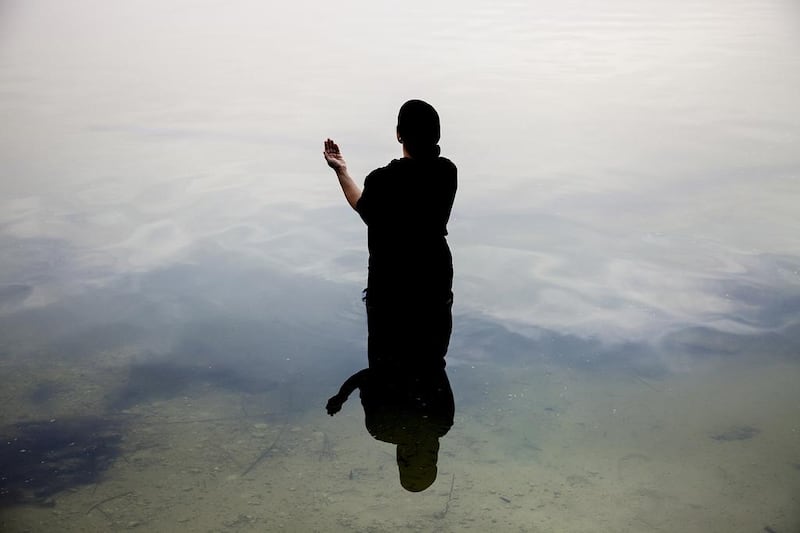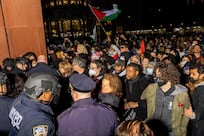As an Iraqi-Palestinian, displacement is something that Sama Alshaibi knows all about. Conflicts over land and oil in both motherlands forced her to live overseas. She settled in the USA and eventually became a naturalised US citizen. But as an artist, Alshaibi is firmly and foremost a global citizen and her art, although it addresses her own issues, is cleverly relevant to anyone who chooses to engage with it.
"We are all a bit nomadic," she says, during a long conversation about Silsila, a video photographic project she began in 2009. "Our world is globalised and people are always moving between communities. Although we are not like the desert Bedouins and we now have planes to jump between points, what I am interested in is what is between those points."
Silsila, which translated from Arabic means chain or link, depicts Alshaibi's cyclic journey through significant deserts and endangered water sources of Jordan, Palestine, Tunisia, Egypt, Lebanon, the UAE, Oman and the Maldives. In poetic silence, or accompanied by ambient sounds, Alshaibi walks through desertscapes and waterscapes inspired by the nomadic traditions of the region and the travel journals of Ibn Battuta, the 14th-century explorer.
“The water is the subject, the sand is the subject and my body is the subject; it is all connected,” she says. “Neither water or sand are constrained by artificial borders that have been placed upon us and so, with this work, I am making an appeal to remind us of all our interconnected relationships. Through travelling, journeying and getting to know each other, we must unite. It is the only way to survive.”
Alshaibi is one of 12 artists showing in an exhibition called Chain of Fire, which serves as a prologue exhibition for the inaugural 2016 edition of the Honolulu Biennial and is copresented by Hawai'i International Film Festival and Honolulu Biennial Foundation. She is also part of an artistic residency under the New Frontiers Program, a cultural and education platform focused on exploring diverse global Islamic communities through the arts. It is supported by the Doris Duke Foundation for Islamic Art, and Shangri La, a Honolulu-based centre for Islamic art and culture.
All the artists will be exhibiting in Our Kaka’ako, a park in a newly hip neighbourhood of the Hawaiian capital.
What is fascinating about the exhibition and the ensuing biennial, set to be curated by prominent Japanese curator Fumio Nanjo, is that although it is happening on a tiny urban hub in the middle of the Pacific Ocean, there are so many connections to the Middle East and the Arab world.
Isabella Ellaheh Hughes, co-founding director of the Honolulu Biennial Foundation, is herself a mix of East and West. Hughes’s father is from Hawaii where she was born and rasied and her mother is from Iran. She is now a well-established art writer and curator based in Abu Dhabi.
She is thrilled at the prospect of establishing an art hub in her nascent country. “You never really think about Hawaii, but it is the meeting point between Oceania, the Asian continent and the Americas and we haven’t yet been on the global stage for art and culture,” she says. “We also wanted to choose regions that connect to the geo-seismic activities or the Ring of Fire – that’s why we chose this theme for the prologue show.”
In her curator's statement, Hughes and the other co-founding director Kóan Jeff Baysa describe Chain of Fire as "an exhibition based on the global elaboration of active volcanic belts within which Hawaii is considered a hot spot, and a trope that links the geo-cultural origins of the artists exhibited."
Also exhibiting is Hasan Elahi, a Bangladeshi-American who presents a site-specific new media installation, using footage taken on a dormant volcano called Mauna Kea in which he questions the power dynamics between the watcher and the watched. Arahmaiani, an artist from Indonesia, tackles issues of water and human intervention in a floor projection and Shigeyuki Kihara, a New Zealand national, examines Samoa’s colonial past.
No matter where you are from or who you are, you can find a reason to connect to Hawaii and therefore the forthcoming biennial, concludes Hughes. “Hawaii is such an evocative place in the urban psyche that everyone has a connection to it. It is the most isolated land mass but somehow it is everywhere and that’s why we hope this event will have the same impact.”
• Chain of Fire will run from October 30 until November 9 at Kaka’ako Agora, Honolulu. For more information visit the website www.honolulubiennial.org
aseaman@thenational.ae





